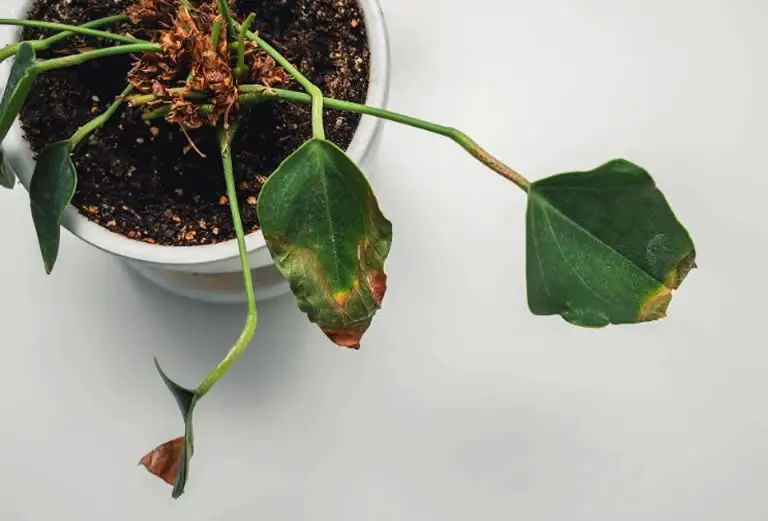Anthuriums are beloved for their glossy foliage and, in many varieties, their long-lasting, vibrant blooms. So it’s understandably frustrating when those lush leaves start turning brown. The good news? Brown leaves don’t have to mean the end of your plant’s health or beauty. With a bit of detective work, you can figure out what’s going wrong and help your Anthurium bounce back.
The most common culprit is too much direct sunlight, which can scorch those elegant leaves.
But there’s a whole list of potential issues—from watering mistakes and humidity drops to pests and natural aging. Let’s dig into each of them so you can get your plant back to thriving.
Table of Contents
- Too Much Sunlight
- Overwatering Can Cause Leaf Browning
- Acclimation Stress Causes Leaf Problems
- Overfertilizing Can Burn Leaves
- Pests Cause Browning Of Anthurium Leaves
- Disease Is Another Problem
- Low Humidity Leads To Leaf Discoloration
- Underwatering Also Leads To Leaf Browning
- Cold Damage Often Shows In The Leaves
- Natural Leaf Aging
- Final Thoughts
Too Much Sunlight
Bright light is great for Anthuriums, but there’s a fine line between “bright” and “burning.”
If your plant is exposed to strong, direct sun—especially through a window in the middle of the day—it’s likely to suffer from scorched, brown patches.
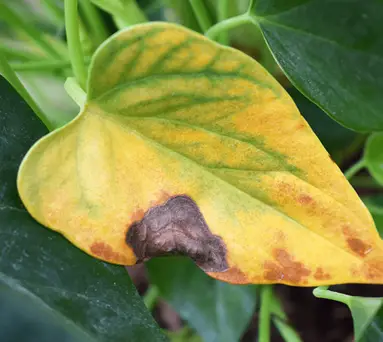
Upper leaves or those facing the light source are typically hit first.
Many people assume more sun is better, but Anthuriums are adapted to dappled light under a jungle canopy. Indoors, that translates to bright, indirect light.
They prefer conditions around 18,000–25,000 lux, which is a fraction of what direct sun delivers.
To fix the issue, move your plant a few feet back from a bright window or diffuse the light with a sheer curtain.
If you’re unsure how bright your spot is, a free light meter app on your phone can give you a rough reading.
Once relocated, hold off on pruning until the plant settles in and starts growing new foliage.
*Note: Leaf burn can also be caused by over-fertilization (see section below).
Overwatering Can Cause Leaf Browning
Overwatering is one of the most common problems across all houseplants, and Anthuriums are no exception.
It’s not just about frequency—overwatering happens when your plant is sitting in soggy soil for too long, often due to poor drainage or a pot that’s too large.
Common signs include yellowing lower leaves, brown tips, and a generally unhappy-looking plant.
Root rot is likely if these symptoms are paired with mushy, dark roots.
To fix it:
-
Remove the plant from its pot and inspect the roots
-
Cut away all black or smelly roots with sterile scissors
-
Rinse away old soil and repot in a loose mix of coco coir or peat, perlite, and pine bark
-
If you’ve removed a significant portion of the roots, trim the foliage to balance the loss
-
Place the plant in bright, indirect light with good humidity
-
Water only when the top inch or two of soil dries out
Recovery may take a few months, but patience and proper care will pay off with fresh, green growth.
Acclimation Stress Causes Leaf Problems
If your Anthurium started browning shortly after you brought it home, don’t panic.
It might just be adjusting to its new environment. Growers maintain plants in ideal conditions—consistent warmth, humidity, and perfect lighting.
Your home, no matter how cozy, is probably a bit less ideal.
Look for browning along the edges of older leaves or the sudden loss of a few lower leaves. This is normal as the plant gets used to its new setting.
To minimize stress:
-
Buy from a reliable seller
-
Avoid ordering online during very cold weather
-
Replicate ideal care conditions as closely as possible (especially humidity and light)
-
Avoid moving your plant from place to place after bringing it home
Give it a few weeks to settle before making any major changes.
Overfertilizing Can Burn Leaves
Fertilizer can help plants grow, but too much can do more harm than good.
Excess fertilizer can burn roots and leaves, leading to browning, especially at the tips or edges.
Crusty white or brown residue on the soil surface is often a giveaway.
If you suspect overfertilization:
-
Flush the soil with water to wash out excess salts
-
Stop fertilizing for several months
-
Consider repotting in fresh soil if the damage is extensive
In general, Anthuriums only need a gentle feeding during the growing season.
Use a balanced, water-soluble fertilizer at half strength every other month, or go the organic route with worm castings or compost blended into the soil.
I find that this liquid feed works great with Anthurium.
Pests Cause Browning Of Anthurium Leaves
Brown spots and irregular patches on the leaves can also be caused by pests.
Thrips, aphids, mealybugs, and spider mites are common offenders.
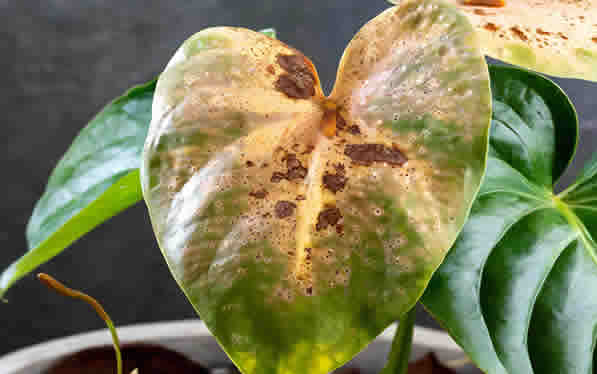
They feed on the plant’s sap and tissue, causing discoloration, deformation, and damage.
Inspect the undersides of leaves, stems, and even the soil line. Early detection is key.
To treat:
-
Isolate the plant from others
-
Remove visible pests manually or rinse them off with lukewarm water
-
Spray with neem oil, isopropyl alcohol, or insecticidal soap every 5–7 days until resolved
-
Always quarantine new plants for two weeks before adding them to your collection
Disease Is Another Problem
Some fungal and bacterial diseases can also result in brown patches on Anthurium leaves.
Pathogens like Fusarium, Pythium, and Xanthomonas thrive in overwatered, humid environments with poor airflow.
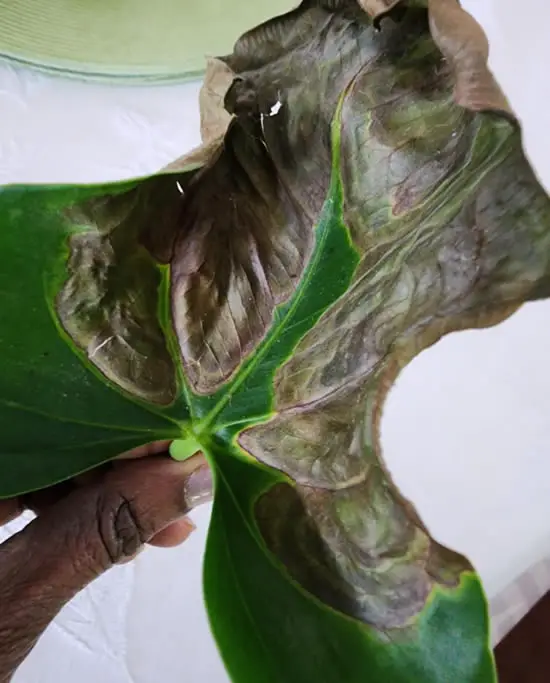
If your Anthurium suddenly develops rapidly spreading brown or black spots, it may be infected.
Unfortunately, topical sprays rarely work once disease sets in.
To respond:
-
Prune off affected leaves immediately
-
Use sterile tools and discard any severely damaged foliage
-
If more than half the plant is affected, it may be best to dispose of it to prevent spreading
-
Avoid high humidity without ventilation, and never allow your Anthurium to sit in wet soil
Low Humidity Leads To Leaf Discoloration
Anthuriums love moisture—not just in the soil, but in the air. When humidity drops, especially in winter or air-conditioned spaces, the leaves may develop brown tips and crispy edges.
To fix this, monitor indoor humidity with a digital hygrometer and aim for 40–60% or higher. Options to boost humidity include:
-
Grouping plants together
-
Setting up a pebble tray with water
-
Relocating to a bathroom or kitchen
-
Using a house or plant humidifier (the most effective long-term solution)
Avoid misting—it provides temporary relief at best and doesn’t raise ambient humidity in a meaningful way.
Underwatering Also Leads To Leaf Browning
While too much water is a problem, not enough can be just as damaging. If your Anthurium’s soil dries out completely or stays dry too long, you’ll see brown edges, wilting, and even dropped leaves. The older leaves typically show signs first.
To prevent this, check your plant every few days and water once the top 1–2 inches of soil is dry. Thoroughly soak the soil and let any excess water drain. Also check that:
-
Your potting mix holds some moisture but drains well
-
Your plant isn’t rootbound, which causes the soil to dry out faster
-
Your Anthurium isn’t placed in too much light or heat, increasing water needs
Cold Damage Often Shows In The Leaves
Anthuriums are tropical by nature and don’t like the cold.
If exposed to temperatures below 59°F (15°C), especially near a drafty window or air conditioning vent, the leaves may begin to yellow and brown over time.
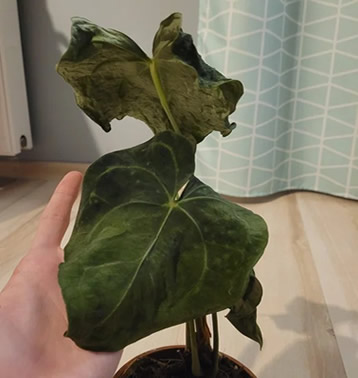
Even brief exposure can cause lasting damage.
To protect your plant:
-
Keep it away from cold windows in winter
-
Avoid letting temperatures drop below 60°F (16°C)
-
Use a digital thermometer to track highs and lows over time
Let the plant recover gradually—wait for new growth before trimming off any damaged leaves.
Natural Leaf Aging
Lastly, don’t forget that leaf aging is completely natural. From time to time, older leaves will turn yellow or brown as the plant redirects energy to newer growth. As long as this happens slowly and sporadically, there’s no reason to worry.
Just keep an eye on your overall care habits, and use this as a gentle reminder to check in on your plant’s lighting, watering, and humidity needs.
Final Thoughts
Brown leaves on an Anthurium might be alarming at first, but in most cases, it’s a solvable problem. Whether it’s adjusting light, tweaking your watering routine, or increasing humidity, small changes can make a big difference.
And remember—every plant parent runs into challenges. Figuring out what went wrong is one of the best ways to learn how to keep your houseplants thriving for years to come.
You may be interested in the following articles about Anthurium care:
Anthurium Care Guide: How to Keep These Tropical Stunners Thriving
Why Your Anthurium Isn’t Blooming and 7 Ways to Encourage Flowers Again
Anthurium Warocqueanum Care Guide
Why Are My Anthurium Leaves Turning Yellow? Causes, Fixes, and Prevention Tips

